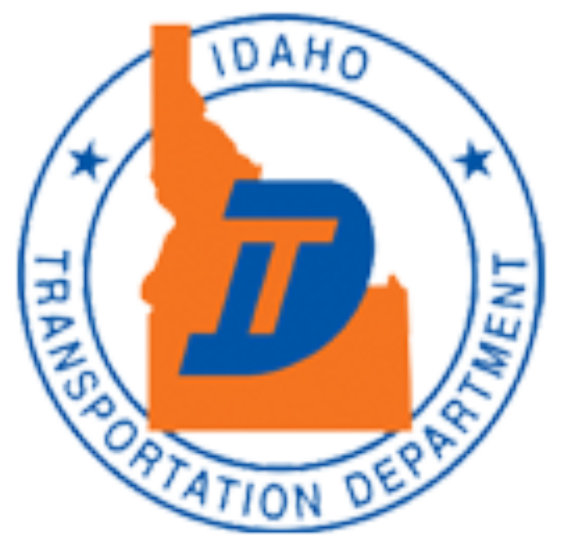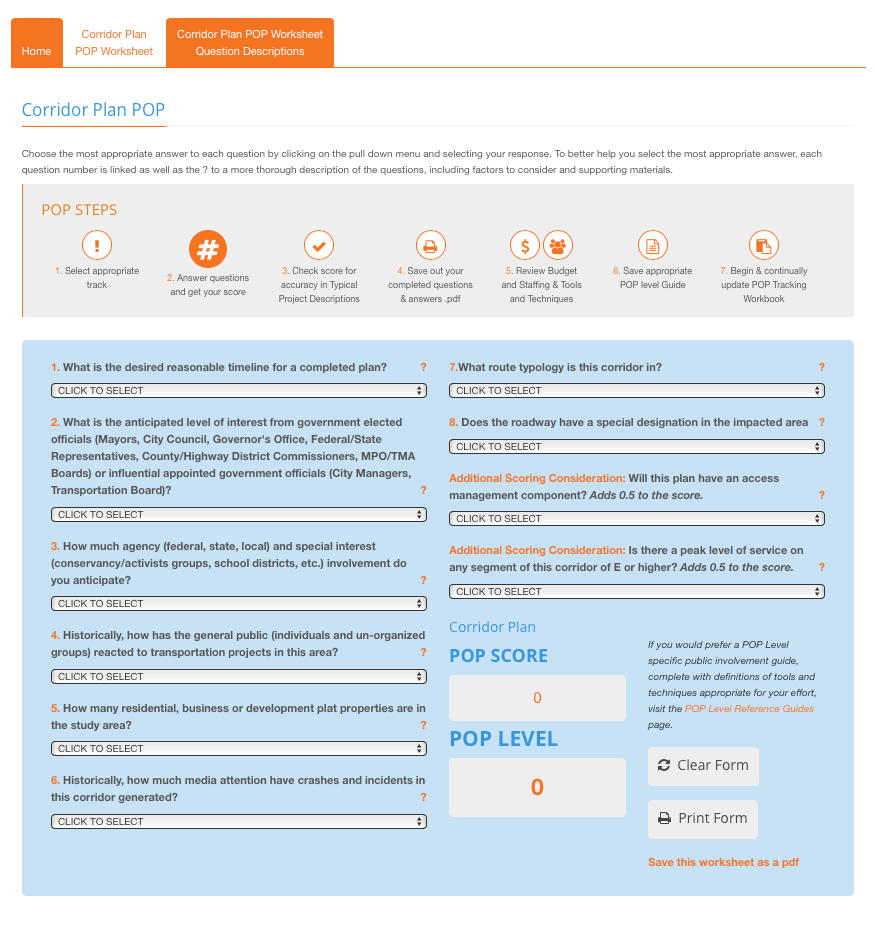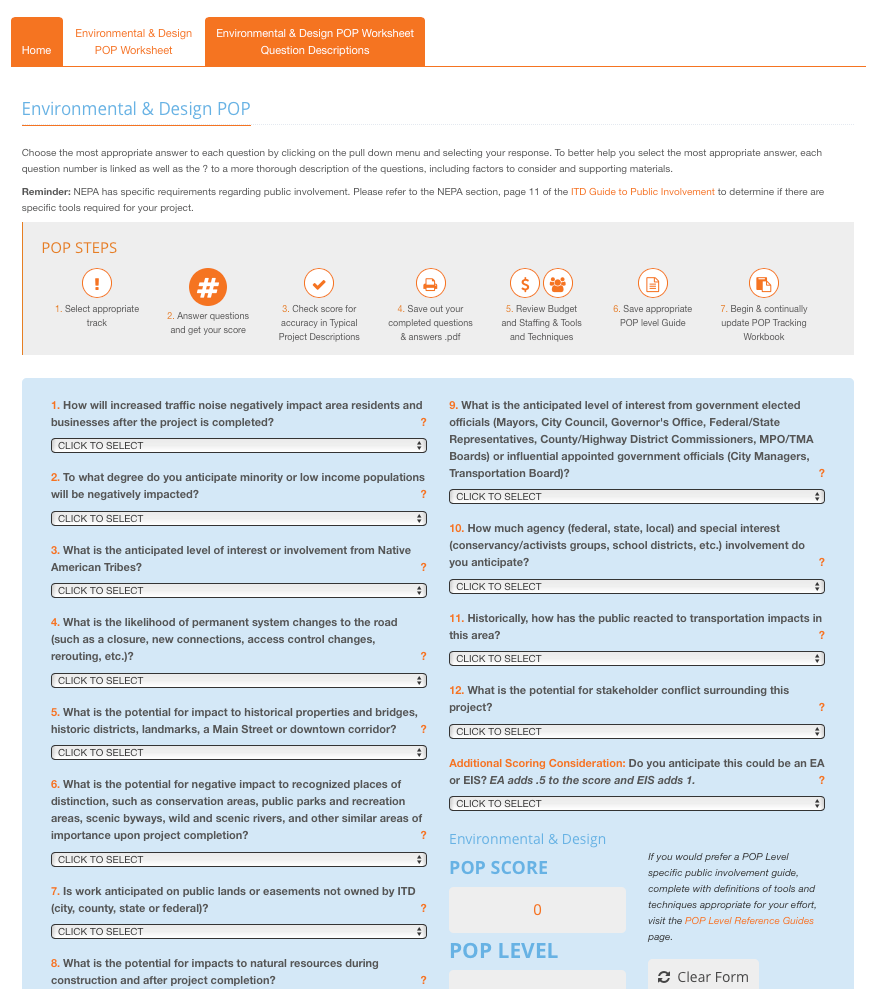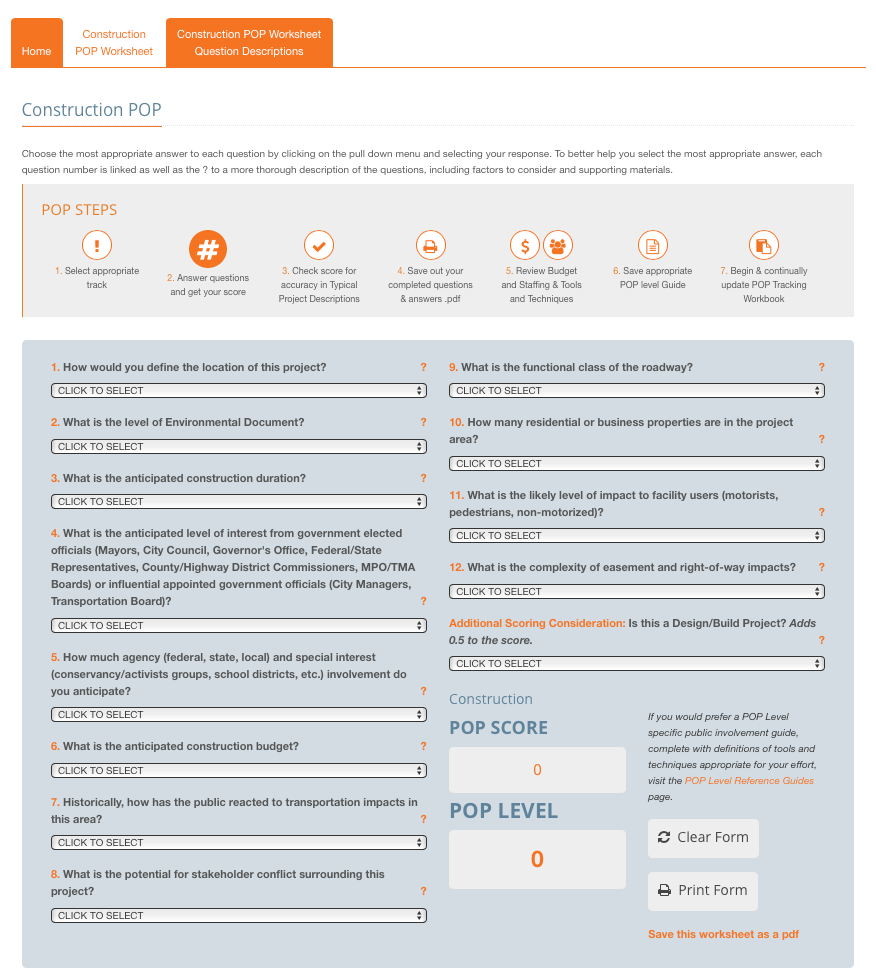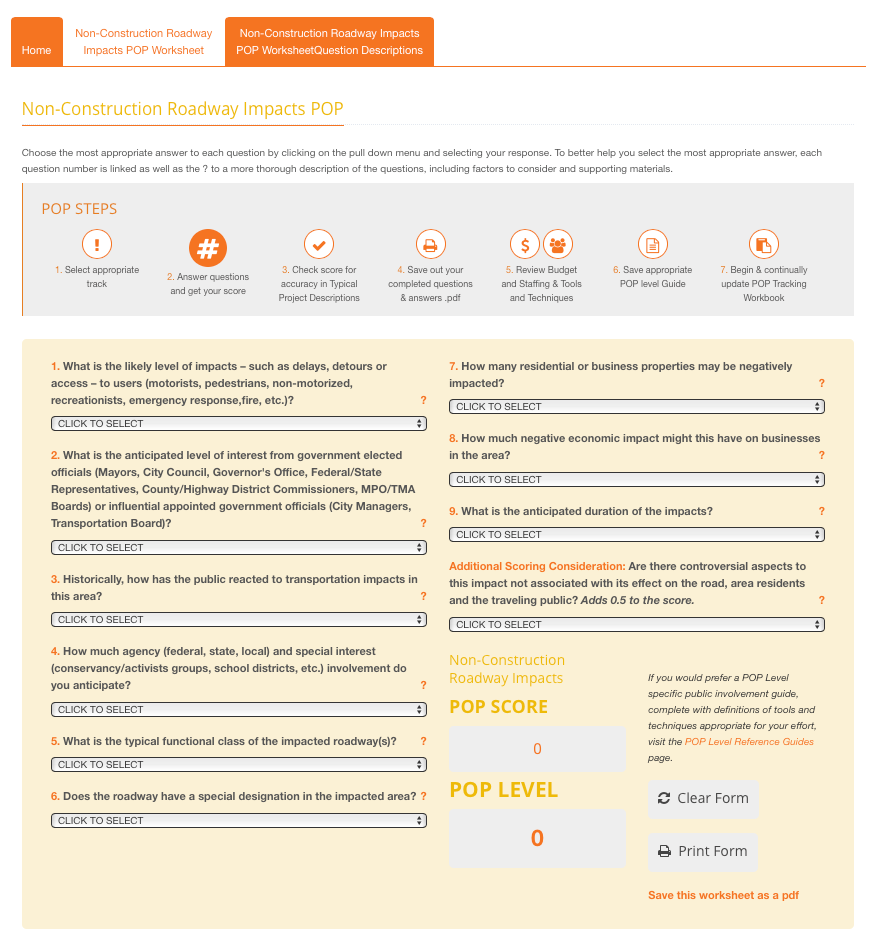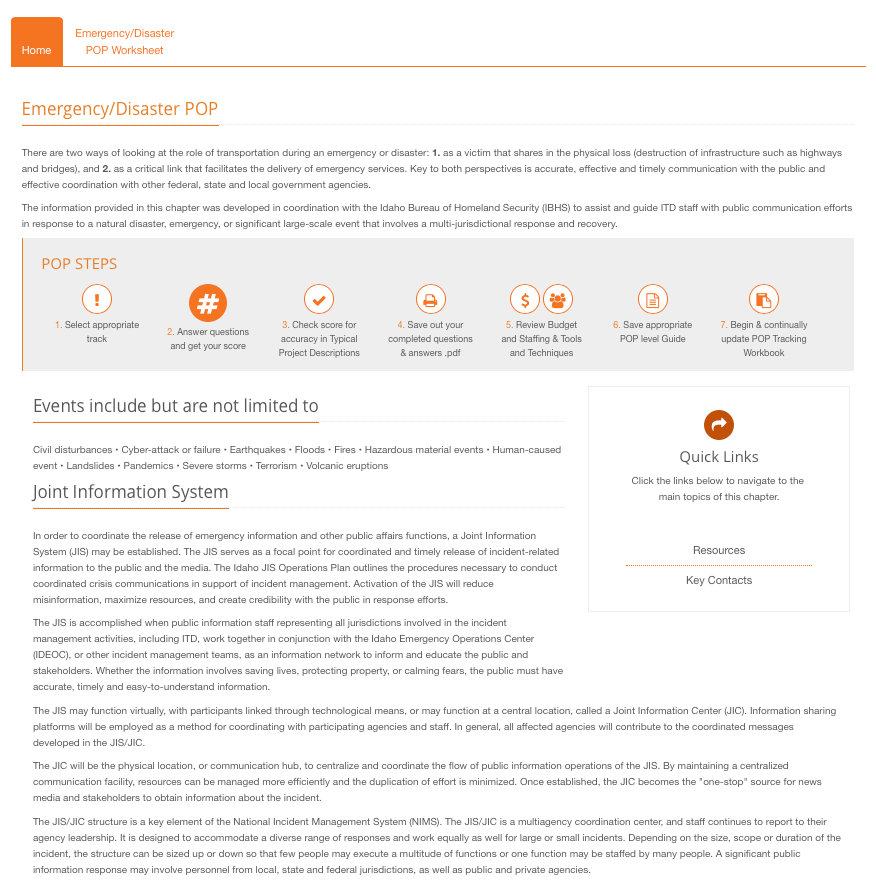About the POP
From concept to construction and through maintenance, the public's needs, concerns and questions must be considered and addressed as the Idaho Transportation Department (ITD) works to improve public safety, enhance mobility and support economic vitality. As such, planning for and executing appropriate strategies to involve and communicate with the public-at-large and individual stakeholders throughout the life-cycle of transportation impacts is critical in the department's effort to maintain transparency.
To effectively manage public outreach plans and activities, ITD staff need information, resources and recommended tools to implement and conduct an affective public outreach effort. The Public Outreach Planner (POP) is that resource. The POP is a tool for analyzing, quantifying and tracking public outreach needs, which will ultimately lead to appropriate and efficient project management.
Quick Links
Click the links below to navigate to the
main topics of this chapter.
How to use the POP
Step 1: Select appropriate track
The first step in meeting any need is defining it appropriately. For communication analysis, it is necessary to consider a wide range of possible impacts and perspectives. As appropriate questions are defined and addressed, a picture begins to emerge that points a project team in a direction for meeting the public's potential needs.
Determine what category your transportation impact best fits. Five "tracks" have been developed to catch all potential transportation impacts in Idaho. They are:
Corridor Plan POP
Medium and long-range highway planning efforts.
This track is designed to help determine the appropriate level of public outreach on corridor planning efforts, before projects are selected and enter the NEPA phase. Corridor plans help determine where future projects are needed.
Environmental & Design POP
Roadway projects that are in or will be entering the environmental phase.
This track is designed to help determine the appropriate level of early public involvement as alternatives are being selected and/or design elements are being determined. Companion projects that fall within the same impact zone will likely be perceived by the public as one project, and should be combined into a single public outreach plan.
Construction POP
Roadway projects that are in or will be entering the construction phase.
If your project is currently in construction or entering the construction phase, this track will help determine the appropriate level of public involvement prior to and throughout roadway construction efforts, including maintenance projects. Companion projects that fall within the same impact zone will likely be perceived by the public as one project, and should be combined into a single public outreach plan.
Non-Construction Roadway Impacts POP
Roadway impact not associated with the plan, design or construction of an infrastructure improvement project.
These types of impacts may include moving oversized loads, transporting hazardous or sensitive materials, festivals, parades, races or any other non-construction roadway action with the potential for public impact.
Emergency/Disaster POP
The Idaho Bureau of Homeland Security (IBHS) has specific procedures in place for emergency and disaster related incidents.
This track provides specific information prepared by IBHS that provides guidance when informing and educating the public during a natural disaster, emergency, or significant large-scale event that involves multi-jurisdictional response and recovery.
Step 2: Answer questions and get your score
For each track, customized multiple-choice questions were developed to address the primary needs, issues and concerns of a variety of stakeholder groups affected by transportation impacts. These questions appear for each track. Each question's answer choices are equally weighted in a scoring range of 1-5, then averaged – this is your POP Score. Your POP Score is then rounded up to give you a recommended POP Level of 1, 2, 3, 4, or 5 – One representing the most minimal public outreach effort and five representing the most robust and extensive level of public outreach.
Your recommend POP Level should be considered the guiding framework for the intensity and methodology of public involvement for any project. It provides the information necessary to write a public involvement plan that takes recommendations from the POP to guide future public involvement activities, budgets and schedules.
Step 3: Check Score for accuracy in Typical Project Descriptions
Knowing your POP Score, a corresponding level of need can be determined by referencing the POP Level Typical Descriptions.This page describes common attributes of transportation impacts for each track, at each POP Level.
This allows the user to refine decisions about the most appropriate POP Level for a transportation impact. For example, a District Project Manager answered the construction POP questions, to the best of her knowledge, for an upcoming road widening project, and landed on a POP score of 2.53. The worksheet automatically rounded up to a POP Level 3 but after reading the typical project description, the project manager feels like her project is less complicated and this description doesn't exactly fit. Because her POP Score fell almost half-way between a 2 and 3, she reads the POP Level 2 description and discovers that this more accurately describes her project and proceeds with Level 2 recommendations.
While simple categorization of outreach need provides the benefit of being able to plan for and better manage multiple projects, project managers and teams should remember that public involvement and outreach is a dynamic process. Adjustments are often required over the life cycle of a project, with corresponding changes in approach, strategy and tasks. Given this, be aware that a project may move from level to level as it evolves from phase to phase, or even within a single project phase. You can never complete the POP questions too often. If it feels like your project has grown less or more complicated, re-answer the questions and see where you come out.
Step 4: Save out your completed questions/answers PDF
It is important to save a PDF of your completed questions/answers in your project file. Instructions for saving can be found at the end of the track questions.
Step 5: Review budget and staffing/tools and techniques
Budgeting: Once the outreach level is determined, the Budget Estimates page provides a framework for approximate budgets that a contractor or third-party public involvement and communication support may propose, for each track and POP Level. This page also provides estimated direct expense associated with public involvement tools, with or without third-party support.
Staffing & Tools: You know your POP level and you have an estimate of how much public outreach might cost, but how do you actually conduct the outreach? For each track and POP Level, the Staffing & Tools page provides customized lists of recommended staff to involve and possible tools and techniques that when done right, have proved successful at effectively involving the public.
Outreach tools listed here are not required, and it is not expected that a transportation impact will exhaust the list for its particular track and POP Level. It is recommended that users work with their SME's to determine which tools and techniques are most appropriate for your project and public.
Tools listed here are detailed in the ITD Guide to Public Involvement, allowing users to learn more about the them, how to develop and implement them, and review examples from past ITD projects.
Step 6: Save out appropriate POP Level Reference Guide
The POP Level Reference Guides provide comprehensive information on public involvement requirements, including definitions, descriptions and examples of tools and techniques. Reference guides pull the relevant information from the ITD Guide to Public Involvement and collect it in customized reference guides for each POP Level.
Step 7: Begin and continually update POP Tracking Workbook
The POP Tracking Workbook is designed to help project teams track and document public involvement throughout the life of a project. This workbook asks specific questions about the project to help current and future project teams:
- Easily locate and reference relevant files, documents and collateral
- Understand project history, trends, public opinions and attitudes
The POP Level Reference Guides act as a supporting document to the tracking Workbook, where the project’s public involvement activities are documented. One POP Tracking Workbook should be used for the life of a project (from Corridor Planning through Construction) and provides a place to track and update public involvement changes, activities and events.
While the POP is meant to provide users with an overview of the outreach planning process and tools to evaluate and meet the needs of a transportation impact, it is critical to note that effective outreach must be custom-designed to fit the impact's needs. Early outreach efforts allow ITD to identify issues up front and plan to deal with them. That said, experience shows that transportation impacts evolve and needs change based on public and agency input, technical and political considerations and the changing funding environment. As such, public involvement and outreach must evolve and adapt to match the evolution of a project.
The POP is intended to assist ITD staff in assessing the range of outreach needs, identifying tools that may be used in meeting those needs, and providing an estimate of the potential costs associated with their implementation. POP Levels and their recommendations are not mandated and staff are not held to any requirements. The POP is a resource designed to help ITD staff make educated decisions about public outreach.
Subject Matter Experts
The ITD Office of Communications staff, Public Involvement Coordinator and region planners are the subject matter experts (SME) on communications and outreach needs and strategy. As such, they are a resource to project managers and project teams. However, given the sheer volume of projects - most of which require some level of public involvement and outreach – the POP has been developed to assist ITD staff in determining the outreach level on any given plan, project or impact, thus streamlining the outreach management decision-making process.
SME's should be kept abreast of all public involvement and outreach decisions. They are a resource to the project team or to the third-party communication support that is procured. Department-wide, SME's must be updated on all activities to coordinate broad-based communications strategy and outreach.
Process Network Integration
To facilitate efficient and effective implementation of the POP, language and activities have been added to existing tasks within the Project Charter and other process networks, including the Environmental Manual and Corridor Planning Guidebook. This integration helps users know when and how the POP should be used to analyze need and to establish appropriate outreach budget estimates, potential tools, activities and recommended team framework for the project.
